Random
Shots
- Po Valley -
Armored Training | Eboli to Rome | To the Arno | Northern ApenninesPo Valley | Vicenza Combat | Post-War | At Ease
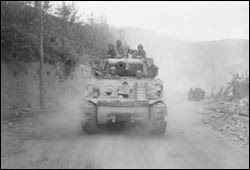 |
A 76mm tank from C Company speeding through Pianoro on the way to Bologna, 21 April 1945. This photo provides a good view of the sloped sides of the T-23 turret and the heavy mantlet for the 76mm gun. Also note the old track fastened over the driver's position for added ballistic protection. (Official U.S. Signal Corps photo). |
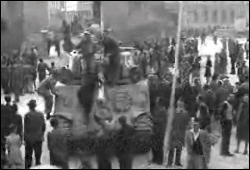 |
The first 752nd tank to enter Bologna on 21 April 1945. The tank has just entered the city through the archway in the distance. A small crowd begins to gather around the tank, as a tanker climbs down to ask directions. Bologna was the fourth large city that the 752nd helped liberate. (Official U.S. Signal Corps photo). |
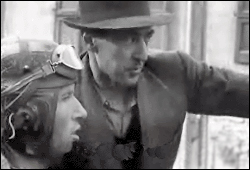 |
A crew member of the first 752nd tank into Bologna receives directions from one of the locals. This is the same tanker who is shown dismounting from the tank in the photo above. (Official U.S. Signal Corps photo). |
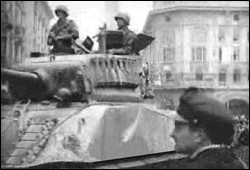 |
Major Woodbury's tank, identified by the upswept name "Betsy II" on its side, enters Bologna as an Italian policeman watches. Note the spare grousers mounted on the side of the turret, and the spare track blocks in front of the driver's position for added ballistic protection. (Official U.S. Signal Corps photo). |
 |
752nd tanks parade down Bologna's Via Rizzoli on 21 April 1945. The long sheets draped across the tank decks are Air Recognition Panels, designed to minimize the chances of attack by friendly aircraft. Each tank had three fluorescent panels (yellow, cerise/pink, or blue), and each panel had a white reverse side. Either single colors or combinations of colors were designated for a given day or operation. (Official U.S. Signal Corps photo). |
 |
A portion of the 752nd assembled briefly in Bologna's main plaza after liberating the city on 21 April 1945. Shown is a mix of 75mm M4 and M4A1 tanks, 76mm M4A3s, M5A1 light tanks, a T2 tank recovery vehicle, and M18 Hellcat tank destroyers. (Official U.S. Signal Corps photo). |
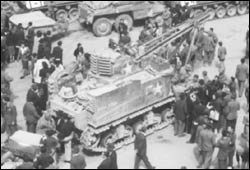 |
A small crowd gathers around a T-2 Tank Recovery Vehicle in Bologna on 21 April 1945. This T-2 belonged to B Company, and was named "Boom Town." It is built on the old M3 chassis, as noted by its high profile and the old M3 bogey trucks with centered track return rollers. Also note the use of "duck bill" end connectors on the tracks, many of which have broken off. (Official U.S. Signal Corps photo). |
 |
752nd M4A3 76mm tanks and M18 Hellcats of the 805th Tank Destroyer Battalion wait for engineers to build a pontoon bridge across the Po River. Photo taken near Revere, Italy on 25 April 1945. (Official U.S. Signal Corps photo). |
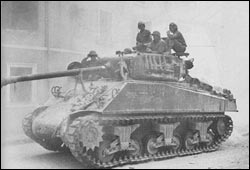 |
752nd tank rolls through the streets of Buttapietra on 26 April 1945. The 752nd received 76mm M4A3s in February 1945, and some were equipped with the relatively rare muzzle brake. Note the absence of markings, the new hull design and T23 turret, the old VVSS suspension system, and well-worn tracks. The Signal Corps caption on this photo incorrectly states the location as Pozzo. The building behind the tank is still in use today. (Official U.S. Signal Corps photo). |
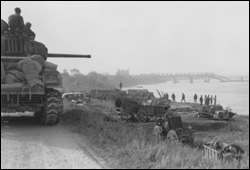 |
A 76mm M4A3 of C Company of the 752nd takes an overwatch position against targets across the Po River, as troops of the 3rd Battalion, 351st Infantry Regiment prepare to cross. Wrecked German motor vehicles and horse-drawn carts litter near bank of the Po. The blown bridge in the distance necessitated the crossing of the Po by amphibious vehicles, and on rapidly constructed pontoon bridges. Photo taken near Ostiglia 24 April 1945. (Official U.S. Signal Corps photo). |
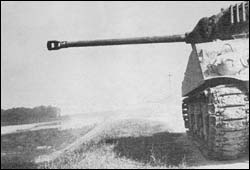 |
A good view of the M1A1C muzzle brake, used to deflect the gun blast to the side in order to minimize target obscuration from dust. This 76mm M4A3 of the 752nd is providing direct fire support as troops of the 88th Infantry cross to the north bank of the Po River. Photo taken 25 April 1945. |
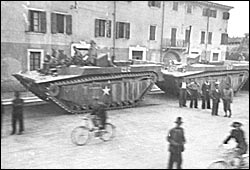 |
Tankers of the 752nd ferried 88th Infantry troops across the Po River in LVT-4 Amtracks (also called Alligators, Fantails, or Water Buffalo). Some 120 LVT's were made available to the 5th Army for crossing the Po at various sites. Original plans called for the entire 755th Tank Battalion to operate all 120 LVTs, and the 755th was pulled off the line in March 1945 to train for this purpose. However, 5th Army plans eventually limited the 755th's involvement to just 40 men, who operated only 20 of the 120 LVTs. Tankers from other battalions such as the 752nd operated the remaining LVTs, although it is not clear how many 752 men were involved. Tankers were used to drive the amphibious vehicles, because the controls and handling characteristics were far more tank-like than boat-like. Shown in this photo are two LVT-4s assembled in the streets of Revere before moving out on 24 April 1945. |
 |
One of the LVT4 Alligators pulls away from the south bank of the Po River on 24 April 1945, in the Ostiglia area. This Amtrack, marked C3C, is carrying 30 men of the 3rd Battalion, 351st Infantry Regiment, 88th Infantry Division. (Official U.S. Signal Corps photo). |
 |
D Company tanks and tank destroyers of the 805th TD wait to cross the Po River on 25 April 1945. These tanks and TD's went on the next day to capture Verona in a daring 30 mile (48 kilometer) dash. Click here to learn more about D Company in action at Verona. (Official U.S. Signal Corps photo). |
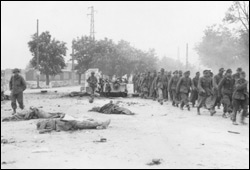 |
German POWs march past their fallen comrades at the junction of Routes 62 and 12 at Verona on 26 April 1945. Called "Bloody Corner" by the GIs, this is where the light tankers of the 752, along with tank destroyers of the 805th TD battalion, took retreating Germans by surprise in fighting the night before. Click here for more details about D Company's action in Verona. (Official U.S. Signal Corps photo). |
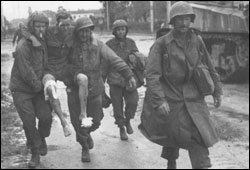 |
28 April 1945 was the 752nd's worst single day for casualties, with 19 men being killed or wounded in action. Here Pvt. Melvin Allen is being evacuated by his crew members, (l-r) Gene Elliott, Wilbur Moore, and Herbert Horne after their tank (in background) was hit by a Panzerfaust in Vicenza. The man on the far right is with the 88th Infantry. (Official U.S. Signal Corps photo). |
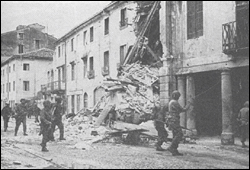 |
Another casualty in the fighting in Vicenza on 28 April 1945. Barely visibile in the rubble, a 752nd tank has just crashed into a building, its driver killed seconds earlier by a sniper. Members of the 88th Infantry check the buildings for the sniper. Click here to see more photos of the 752 in action in Vicenza. (Official U.S. Signal Corps photo). |
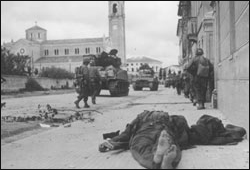 |
752nd tanks and men of the 88th Infantry Division advance along via Littorio as they liberate Cornuda on 30 April 1945. The street is now called via 30 Aprile in honor of the liberation. A dead German soldier, already stripped of his boots, lies where he fell. The church Chiesa Arcipretale is in the distance. (Official U.S. Signal Corps photo). |
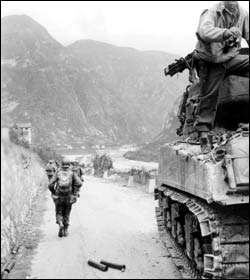 |
A B Company M4A3 provides support for doughboys of the 350th Infantry Regiment on the road to Feltre. The Piave River is on the right, and the Alps are straight ahead. Note the five spent 76mm shell casings on the road. This photo was taken on 1 May 1945, the day before the war in Italy ended. This tank is equipped with duckbill end connectors to provide better "flotation" on soft ground. Several connectors have broken off. (Official U.S. Signal Corps photo). |
Researched and Written by Robert
J. Holt
Page Content Copyright 2003 - 2025 Robert J. Holt
All Rights Reserved